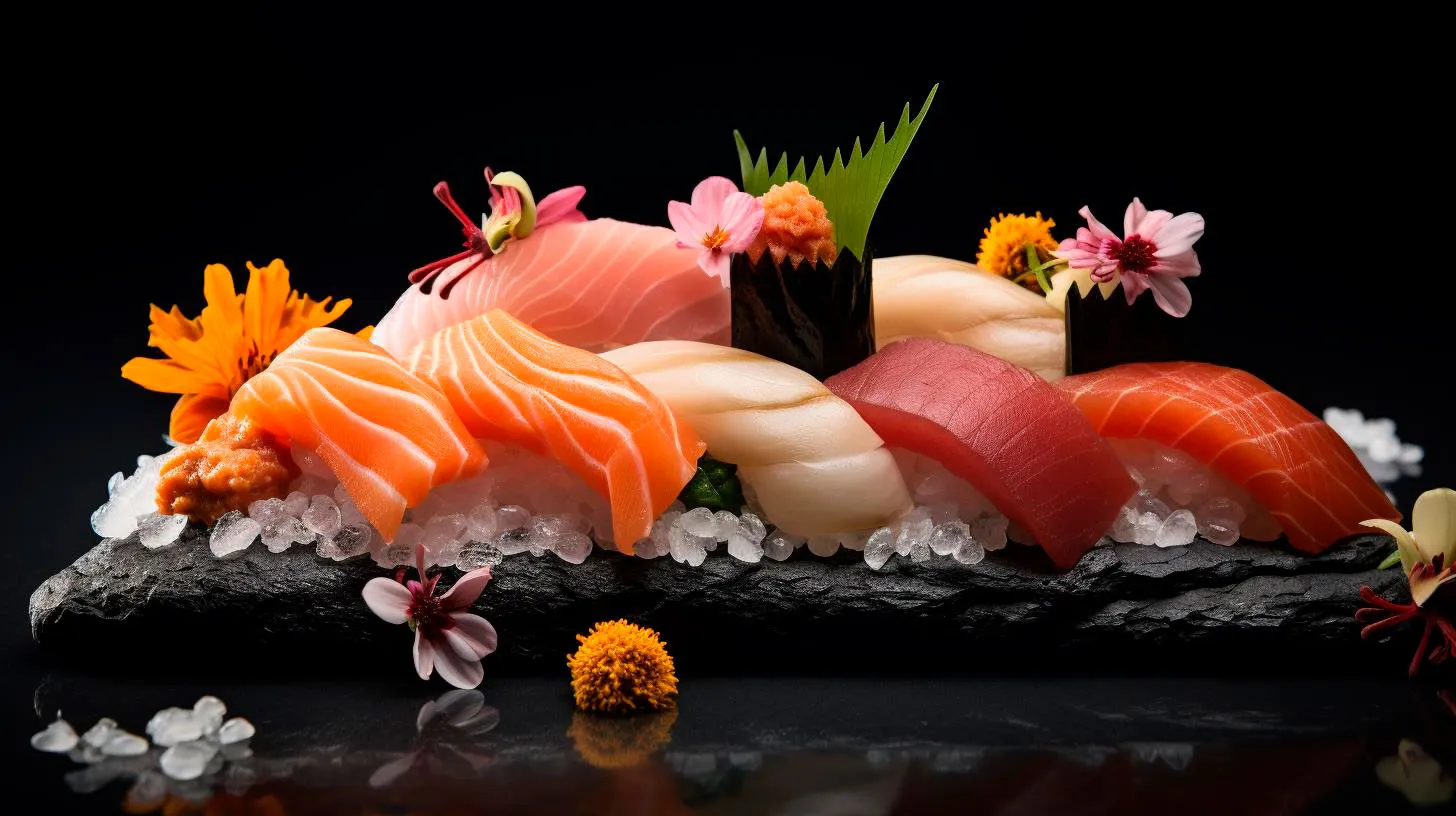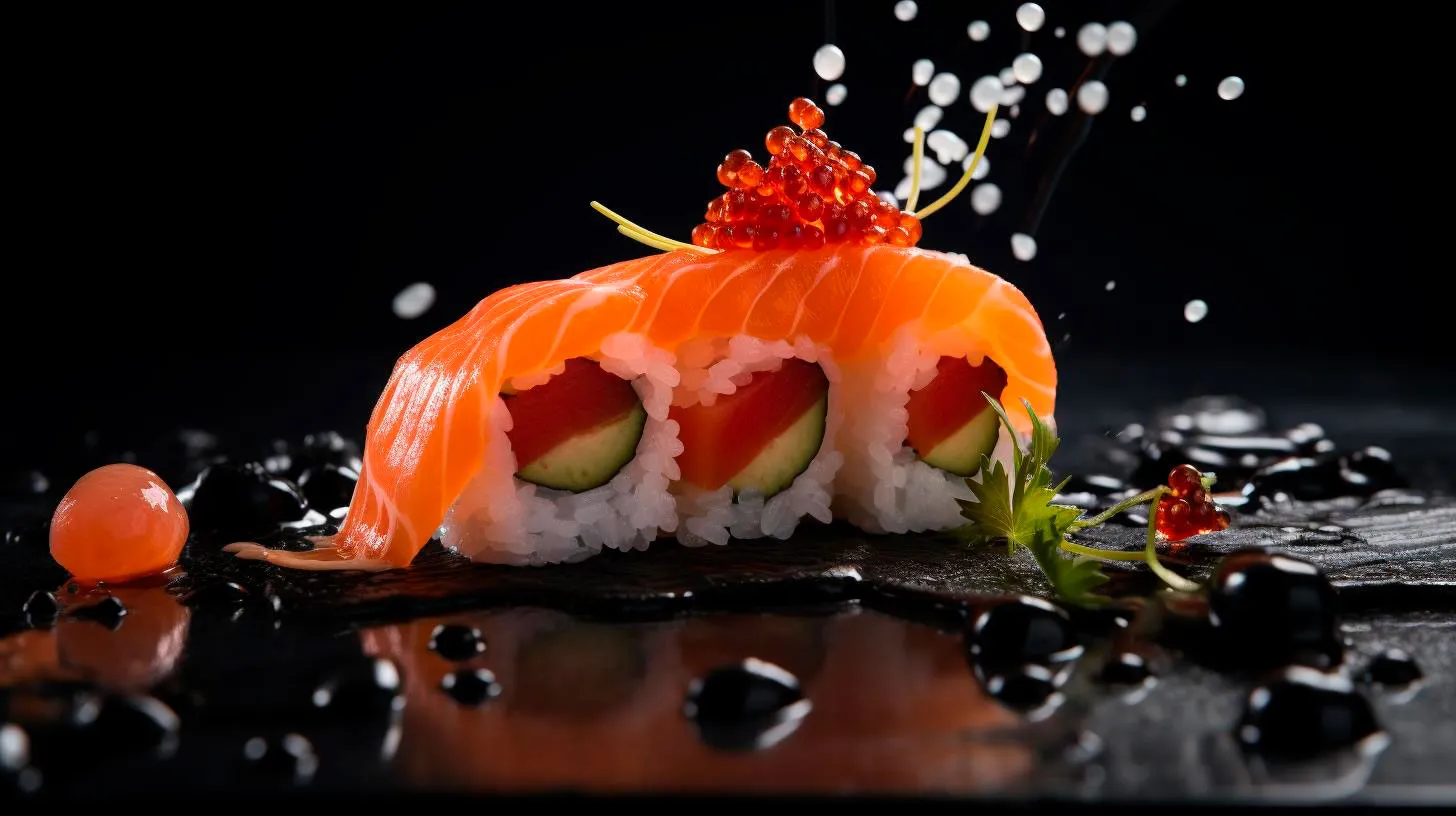Shrimp: A Flavorful Sushi Filling with Moderate Allergy Potential
However, it’s important to note that shrimp does come with a moderate allergy potential that sushi lovers should be aware of.
The Flavorful Delicacy: Shrimp
Shrimp, with its distinct taste and succulent texture, has become a staple ingredient in sushi. Whether enjoyed as nigiri, rolls, or sashimi, shrimp offers a burst of flavor that complements the other ingredients in sushi. Its subtly sweet and briny taste adds depth to the overall sushi experience.
Key Takeaway: Shrimp adds a burst of flavor to sushi with its subtly sweet and briny taste.
While shrimp undeniably enhances the sushi experience, it’s essential to consider its allergy potential. Shrimp allergies are relatively common, affecting both children and adults. These allergies are usually caused by the proteins found in shrimp, particularly tropomyosin. If you have experienced allergic reactions to other shellfish or food allergies in the past, it’s advisable to exercise caution when consuming shrimp sushi.
Allergy Potential and Sensitivities
Shrimp allergies can range from mild to severe, with symptoms varying from person to person. Some individuals may only experience mild symptoms, such as itchiness and hives, while others may face more severe reactions, including difficulty breathing, swelling of the throat, or even anaphylaxis – a life-threatening allergic reaction.
Key Takeaway: Shrimp allergies can vary in severity, with symptoms ranging from mild itchiness to life-threatening anaphylaxis.
If you suspect you have a shrimp allergy, it is crucial to consult an allergist for a proper diagnosis. They can conduct tests to determine whether you are allergic to shrimp or other shellfish. In the case of a confirmed shrimp allergy, it’s best to avoid consuming shrimp altogether to prevent potential allergic reactions.
Preventing Cross-Contamination
For those who are not allergic to shrimp but may be dining with someone who is, it’s important to prevent cross-contamination when handling and preparing sushi. Cross-contamination occurs when an allergen, in this case, shrimp, comes into contact with other ingredients in the kitchen or during the sushi-making process.
To minimize the risk of cross-contamination, restaurants and sushi chefs should follow strict food safety protocols. This includes thoroughly cleaning cutting boards, knives, and other utensils that come into contact with shrimp to prevent traces of shrimp proteins from transferring to other ingredients.
Key Takeaway: Restaurants and sushi chefs should follow proper food safety protocols to prevent cross-contamination and protect allergic individuals.
Furthermore, it’s important for individuals with shrimp allergies to communicate their dietary restrictions to their sushi chefs or restaurant staff. By clearly stating their allergy, precautions can be taken to avoid any contact between shrimp and their sushi preparation. Restaurants often have special procedures in place to accommodate customers with food allergies.
Alternative Sushi Fillings
If you or your dining companions have shrimp allergies, don’t fret! Sushi offers a wide array of alternative fillings that are equally delicious and safe for consumption. Some popular options include:
- Salmon: Offers a rich and buttery flavor, perfect for sushi enthusiasts looking for an alternative to shrimp.
- Tuna: Known for its meaty texture and bold taste, tuna adds a burst of umami to sushi rolls.
- Avocado: Creamy and nutritious, avocado is a versatile sushi filling that adds a smooth texture to rolls.
- Cucumber: Crisp and refreshing, cucumber is a popular choice for vegetarians and sushi lovers seeking a light and crunchy filling.
Key Takeaway: There are numerous delicious alternatives to shrimp, such as salmon, tuna, avocado, and cucumber, that can be enjoyed by those with shrimp allergies.
By exploring these alternative fillings, you can still indulge in the flavors of sushi while avoiding any allergic reactions. Whether you choose a classic salmon roll or embrace the creamy goodness of avocado, sushi offers a diverse range of options to suit everyone’s palate.
In conclusion, shrimp is undoubtedly a flavorful sushi filling that adds a unique twist to this beloved Japanese delicacy. However, it’s important to consider the moderate allergy potential associated with shrimp. Individuals with shrimp allergies should exercise caution and avoid consuming shrimp to prevent any adverse reactions. Restaurants and sushi chefs should also prioritize food safety protocols to prevent cross-contamination and protect allergic individuals. Nevertheless, sushi enthusiasts can still enjoy a wide variety of delicious alternatives to shrimp, such as salmon, tuna, avocado, and cucumber. So, go ahead and savor the delightful flavors of sushi while making informed choices about your dining experience.
Salmon: Delicious and Nutritious but Watch Out for Allergies
In this article, we will explore the health benefits of salmon, discuss allergy symptoms, and provide insights on prevention. So, let’s dive in!
The Health Benefits of Salmon
Salmon is not just a treat for your taste buds; it also offers several health advantages. Here are some key benefits:
- Rich in Omega-3 Fatty Acids: Salmon is loaded with Omega-3 fatty acids, particularly EPA and DHA, that promote brain health, reduce inflammation, and support heart health.
- Excellent Source of Protein: Protein is an essential macronutrient, and salmon provides a high-quality source of protein that aids in muscle repair, growth, and overall development.
- High in B Vitamins: Salmon contains B vitamins like B12, niacin, and B6, which are crucial for energy production, metabolism, and maintaining a healthy nervous system.
- Rich in Minerals: This fish is a great source of minerals such as selenium, potassium, and phosphorus that contribute to bone health, regulate blood pressure, and support various physiological processes in the body.
- Supports Eye Health: The presence of antioxidants, specifically astaxanthin, in salmon can contribute to improved eye health and reduce the risk of age-related macular degeneration.
Symptoms of Salmon Allergies
While salmon is generally safe for consumption, some individuals may develop an allergic reaction to this fish. Allergic reactions can be mild, moderate, or severe, and symptoms may vary from person to person. Here are some common signs of salmon allergies:
- Skin Reactions: Itching, redness, and hives are often observed in individuals with salmon allergies. These reactions may occur immediately or develop a few hours after consuming salmon.
- Gastrointestinal Issues: Some individuals may experience nausea, vomiting, stomach cramps, or diarrhea after eating salmon.
- Respiratory Problems: Difficulty breathing, wheezing, and coughing may be signs of an allergic reaction to salmon.
- Anaphylaxis: In rare cases, a severe allergic reaction known as anaphylaxis can occur, leading to a sudden drop in blood pressure, dizziness, swelling of the throat, and even loss of consciousness. This is a medical emergency and requires immediate attention.
Preventing Salmon Allergies
If you suspect or have been diagnosed with a salmon allergy, it’s crucial to take necessary precautions to avoid allergic reactions. Here are some preventive measures to consider:
- Elimination: Completely avoiding salmon and other seafood products derived from salmon is the most effective way to prevent allergic reactions.
- Reading Labels: Be vigilant while grocery shopping and carefully read food labels to check for any potential presence of salmon or salmon derivatives in processed foods.
- Restaurant Awareness: Inform restaurant staff about your allergy to salmon, ensuring they take necessary precautions when preparing your food.
- Carry an EpiPen: If you have a severe allergy, carrying an epinephrine auto-injector (EpiPen) can be life-saving in case of accidental exposure to salmon or a severe allergic reaction.
- Education and Awareness: Stay informed about potential hidden sources of salmon in various cuisines, as it may be used as an ingredient or garnish without being explicitly mentioned.
Safeguarding yourself from salmon allergies allows you to enjoy other seafood and reap their nutritional benefits without compromising your health.
Conclusion
Salmon undoubtedly deserves its reputation as a delicious and nutritious fish. Packed with Omega-3 fatty acids, proteins, minerals, and vitamins, it offers numerous health benefits. However, for individuals with salmon allergies, consumption can lead to allergic reactions with varying symptoms. By being aware of potential allergy symptoms, taking necessary precautions, and having an emergency plan in place, individuals can continue to indulge in other seafood options while staying healthy.
Remember, moderation is key, and if you suspect an allergy, it’s always advisable to consult with a healthcare professional to ensure an accurate diagnosis and appropriate management.
Tuna: A Common Sushi Filling with Minor Allergy Risk
In this article, we will explore the minor allergy risks of tuna and discuss some essential precautions to ensure a safe and enjoyable sushi experience.
The Allure of Tuna Sushi
Tuna sushi is a staple in Japanese cuisine and has gained immense popularity worldwide. The rich, savory flavor of tuna combined with the delicately seasoned rice and a touch of wasabi creates a culinary delight. Tuna’s smooth, meaty texture and its ability to pair well with other ingredients make it an excellent choice for sushi rolls and nigiri.
Understanding the Allergy Risk
While tuna is generally safe to consume, there is a minor risk of developing an allergy to this popular fish. According to the American College of Allergy, Asthma & Immunology (ACAAI), tuna allergies are relatively rare compared to other seafood allergies. However, individuals with fish allergies may experience adverse reactions when consuming tuna.
Tuna allergies usually manifest as an immune response triggered by the proteins found in tuna. Common symptoms of a tuna allergy include:
- Hives or skin rash
- Nausea or vomiting
- Stomach cramps
- Diarrhea
- Swelling of the lips, tongue, or throat (angioedema)
- Difficulty breathing or wheezing
In rare cases, a severe allergic reaction known as anaphylaxis can occur, leading to a potentially life-threatening situation. If you experience any of these symptoms after consuming tuna sushi, seek immediate medical attention.
Protecting Yourself from Tuna Allergies
Preventing allergic reactions to tuna sushi is crucial for individuals with known fish allergies. Here are some essential precautions to take:
- Know your allergies: If you have a known fish allergy, it’s essential to inform sushi chefs or restaurant staff about your condition before ordering. This information allows them to take necessary precautions and provide suitable alternatives.
- Opt for alternatives: If you have a tuna allergy or want to avoid the risk altogether, consider other sushi fillings such as salmon, crab, or vegetarian options like cucumber or avocado rolls.
- Read labels and menus carefully: When purchasing pre-packaged sushi or dining out at a sushi restaurant, carefully read menus and ingredient labels to ensure there are no hidden tuna preparations.
- Communicate your needs: Clear communication with staff is crucial to ensure your safety. Ask questions about the ingredients and preparation methods to make informed choices.
- Consider cross-contamination: Cross-contamination is a potential risk for people with allergies. Ensure that utensils and preparation surfaces are clean and not used for both tuna and other sushi fillings.
- Carry emergency medication: If you have a severe allergy to tuna or other seafood, always carry an emergency epinephrine auto-injector (EpiPen) with you in case of anaphylactic reactions.
The Verdict: Enjoy Tuna Sushi Responsibly
While tuna allergies are relatively rare, it is crucial to be aware of the potential risks associated with consuming this popular sushi filling. By taking necessary precautions and following our guidelines, individuals with allergies can safely enjoy sushi without compromising their health. Remember to communicate your needs with sushi chefs or restaurant staff and consider alternatives if you have known seafood allergies. With responsible consumption, tuna sushi remains a delightful and flavorful option for sushi enthusiasts around the world.
Key Takeaways:
- Tuna is a popular sushi filling known for its rich flavor and smooth texture.
- Although tuna allergies are relatively rare, individuals with fish allergies may experience adverse reactions.
- Symptoms of a tuna allergy can range from mild hives and stomach cramps to severe anaphylaxis and difficulty breathing.
- Precautions such as informing sushi chefs about your allergies, reading labels, and considering alternatives can help prevent allergic reactions.
- Responsible consumption and clear communication with staff are essential for individuals with seafood allergies.
Sources:
- American College of Allergy, Asthma & Immunology. “Seafood Allergy.” Available at: [URL]
- Food Allergy Research & Education. “Fish Allergy.” Available at: [URL]
Avocado Allergy-Free and Popular Sushi Ingredient for Vegetarians
The Rise of Avocado in Sushi
In recent years, avocado has seen a surge in popularity as a sushi ingredient, both in traditional sushi restaurants and trendy sushi joints. Once considered an unconventional choice, avocado has now become a staple in many sushi menus around the world. This rise in popularity can be attributed to several factors:
- Texture: Avocado’s smooth and creamy texture perfectly complements the soft rice and delicate fish commonly found in sushi rolls. It adds a pleasant creaminess that contrasts with other crunchier ingredients.
- Flavor: With its mild nutty taste, avocado provides a subtle and rich flavor that enhances the overall taste profile of sushi rolls. It adds a refreshing note that balances the savory elements in the dish.
- Health Benefits: Avocado is not only delicious but also packed with nutrients. It is a good source of healthy fats, vitamins, and minerals such as vitamin K, vitamin E, and potassium. These nutritional properties make it an excellent choice for health-conscious individuals.
- Allergy-Friendly: Unlike many other common sushi ingredients, avocado is typically safe for people with food allergies or intolerances. It does not contain gluten, dairy, or seafood allergens, making it a versatile option for those with dietary restrictions.
Avocado as a Vegetarian-Friendly Sushi Ingredient
Avocado has become a go-to ingredient for many vegetarians who enjoy sushi. As a plant-based alternative to fish, avocado provides a similar creamy texture and adds a layer of richness to vegetarian sushi rolls. Key advantages for vegetarian sushi enthusiasts include:
- Protein Substitute: While traditional sushi often includes fish as a source of protein, avocado offers a vegetarian-friendly substitute. It contains all the essential amino acids, making it a valuable addition to a vegetarian diet.
- Nutritional Value: Avocado is packed with healthy fats, fiber, and various important nutrients. It provides a satisfying and nutritious option for vegetarians who want to ensure a well-balanced sushi meal.
- Flavor Enhancement: Avocado’s mild and buttery taste can enhance the flavors of vegetarian sushi rolls. It pairs well with a variety of vegetables, seaweed, and sauces, creating a harmonious blend of flavors in each bite.
Key Takeaways
In conclusion, avocado has become a popular and allergy-free sushi ingredient for both vegetarians and non-vegetarians alike. Its smooth texture, rich flavor, and nutritional benefits make it a versatile choice that can enhance the overall sushi experience. Whether you are trying to accommodate dietary restrictions or simply looking to explore new flavors, avocado is a great addition to your sushi rolls.
Key takeaways from this article include:
- Avocado has become a popular sushi ingredient due to its texture, flavor, and health benefits.
- It is allergy-free, making it a safe choice for people with food allergies or intolerances.
- For vegetarians, avocado serves as a protein substitute and enhances the nutritional value of sushi rolls.
- Avocado’s mild and buttery taste complements various sushi ingredients and enhances flavor profiles.
- Adding avocado to sushi rolls adds a creamy and satisfying element to the overall dish.
So, next time you crave sushi, consider trying a roll that includes avocado. You’ll not only enjoy a delicious and allergy-free experience but also reap the nutritional benefits of this versatile fruit.


